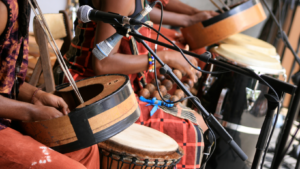West African music pulses with a rich tapestry of rhythms and melodies, capturing the heart and soul of a vibrant cultural heritage. It’s a region where music isn’t just an art form; it’s a way of life, deeply woven into the fabric of daily existence and communal celebrations. From the entrancing beats of the djembe to the melodic kora, West African sounds have transcended borders and influenced global music genres.
The diversity of West African music reflects the continent’s vast cultural landscape, with each tribe and community offering its unique musical expressions. Whether it’s the infectious Afrobeat pioneered by legends like Fela Kuti or the traditional griot storytelling, West African music serves as a powerful medium for communication and social cohesion. As listeners explore these sounds, they embark on a journey through history, tradition, and innovation, uncovering the universal language of rhythm and harmony that connects us all.
West African Music
 West African music enchants listeners with its rhythmic complexity and melodic richness. It has deep roots in local traditions and influences global musical landscapes. Instruments like the djembe and balafon create a unique soundscape that reflects the region’s cultural diversity.
West African music enchants listeners with its rhythmic complexity and melodic richness. It has deep roots in local traditions and influences global musical landscapes. Instruments like the djembe and balafon create a unique soundscape that reflects the region’s cultural diversity.
Instruments and Rhythms
Traditional instruments dominate the West African musical scene. The kora, a 21-string lute-bridge-harp, generates melodious tones crucial for storytelling. Drums, such as the djembe and talking drum, produce intricate rhythms that drive ceremonial and social dances. Each rhythm serves a purpose, often connected to specific rituals.
Genres and Traditions
Various genres thrive in West African music. Afrobeat combines highlife, funk, and jazz elements, popularized by artists like Fela Kuti. The griot tradition uses music and oral narratives to preserve history. This storytelling form remains vital across countries like Mali and Senegal, emphasizing community values and collective memory.
The Roots of West African Music
 West African music originates from a rich tapestry of history and diverse cultural influences. Its melodies and rhythms intricately weave together stories, traditions, and innovations.
West African music originates from a rich tapestry of history and diverse cultural influences. Its melodies and rhythms intricately weave together stories, traditions, and innovations.
West African music’s roots trace back thousands of years. Ancient empires like Mali and Ghana, along with kingdoms such as Songhai, developed complex musical traditions that reflected their societal structures. Music played a key role in ceremonies, oral history, and community gatherings. The griots, or oral historians, were pivotal; they preserved historical narratives and genealogies through song and dance. Instruments like the kora and balafon were integral to these performances, creating sounds that embodied the spirit of the people.
Cultural Influences
Cultural influences on West African music are vast and varied. The fusion of indigenous sounds with those of Arab traders and European colonizers led to an evolving musical landscape. Religions like Islam and Christianity introduced new themes and tonalities. The transatlantic slave trade disseminated West African rhythms globally, impacting genres such as jazz, blues, and reggae. Today, cross-cultural exchanges continue to shape the music, incorporating elements from hip-hop, pop, and electronic styles while preserving the essence of traditional sounds. These influences reveal the adaptability and enduring appeal of West African music.
Traditional Instruments of West African Music
 Traditional West African music thrives due to an array of unique instruments. These instruments influence the rhythm, melody, and harmony that define the region’s sound.
Traditional West African music thrives due to an array of unique instruments. These instruments influence the rhythm, melody, and harmony that define the region’s sound.
Drums are central to West African music. The djembe, a goblet-shaped drum covered with animal skin, produces a wide range of sounds. Skilled drummers use their hands to create complex rhythms that guide dancers and ceremonies. Another key instrument is the talking drum, known for its hourglass shape and tension-adjustable strings. It mimics human speech and serves as a communication tool across villages. Balafons, wooden xylophones with gourd resonators, add melodic percussion to ensembles.

